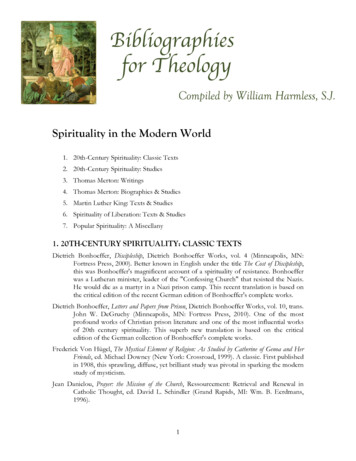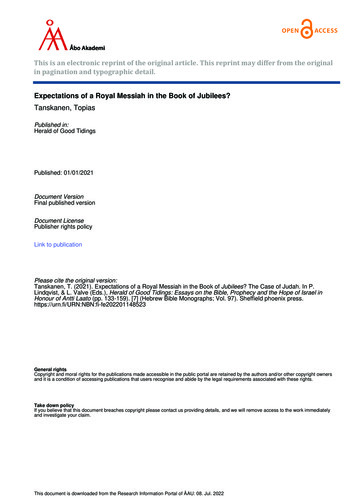
Transcription
D I G I TA L R E P R I N TISSOURIANMColumbia, MissouriMay 3-8, 2003Legacy of a lynchingColumbia remembers racial injusticeBY BA RTON GROV E R HOW E5-part seriesPart 1Part 2Part 3Part 4Part 5An attack in black and white, 2Different definitions of justice, 4And no one lived happily ever after, 7Successes and secrets, big and small, 10The next generation and lessons learned, 12Visit our Web site at: www.ColumbiaMissourian.com
1COLUMBIA MISSOURIANCharactersJames T. ScottProminent black residentof Columbia, decorated forvalor in World War I. Hewas accused of the attackon Regina.Regina Almstedt14-year-old ColumbiaHigh School student. Shewas attacked under theStewart Street bridge inApril of 1923.Hermann AlmstedtUniversity of Missouriprofessor of German from1901 to 1942. Father ofRegina, he tried to save thelife of James T. Scott.Charles NutterUniversity of Missouristudent and ColumbiaEvening Missourianreporter. He coveredScott’s lynching andtried to save Scott’s life.George BarkwellCity contractor, businessman and former city councilman. He was accused ofplaying a larger role in thelynching.May 3-7, 2003 — Page 2An attack in black and whiteJames T. Scott looked at the crowdgathered on the Stewart Streetbridge. Screaming, yelling, theywanted justice.Amazingly, he was surrounded byother community leaders. Next to himwas aformer city councilman, nearby, abanker. There were even a few fellowveterans of the Great War gathered.They, too, were calling for a killing.He’d seen a university professor begthem to stop, but they wouldn’t. A localreporter had tried as well. But Scottwatched as the mob continued.As he watched, a pair of handsreached out and grabbed him.They hoisted Scott to the rail of thebridge. What had begun under this verybridge eight days ago would be overin seconds, unless someone could stopthose giant, white hands.nnnWhat has become an 80-year-old legacy of secrets kept and revealed beganat about 3:30 p.m. April 20, 1923. Regina Almstedt was walking quickly weston Maple Street, which led to StewartRoad and the bridge over the MKT railroad tracks. A 14-year-old sophomoreat Columbia High School, her musiclessons were on the other side of town,closer to the university.Her dress flapped lightly as shewalked. The temperature was in thelow 70s, and even though it hadn’trained for weeks, she carried anumbrella; in the spring, weather couldbe unpredictable.She was only a few blocks from herhome on Garth Street when a blackman approached her. He said he neededher to come into the ravine becausethere was a baby down near the railroad tracks.Regina was a baby sitter to manylocal children. She reasoned it might beone of the children she cared for, so shestarted down the slope into the 30-footdeep ravine.At the tracks, Regina still could seeno one. She followed the tracks aroundthe bend to the west but could still findnothing. By now, the man had comedown into the ravine and seemed to befollowing her.She decided something was wrongand started to cross into the woods tothe south rather than walk back up thetracks and pass the man. She began toclimb the slope out of the ravine.But it was too late.The man grabbed her by the arm.He forced her farther into the woods.He told her, “A white man stole mywife, and I am determined to get evenand made up my mind to ruin the firstwhite woman I got a chance at.”With her umbrella, she smashed theman about the face and head, breaking the umbrella into pieces. But it wasno use. He pulled a belt from his pantloops and tightened it around her neck,then punched her in the face severaltimes. He then pulled a knife and toldher he would use it if she made anynoise.On the tracks below, a small MKTrailroad work crew passed by on ahandcar. Despite the belt around herneck, Regina screamed to get theirattention. Her assailant quickly stuffeda handkerchief in her mouth.She continued to struggle. Hopingrobbery was his true motive, she managed to free a 50-cent coin from herpocket and fling it to the ground. Hetold her he did not want the moneybutgot up and took it anyway.He asked her if it would be necessaryto tie her to a tree or if she would waitthere while he got away. She told himshe would wait.As soon as he was out of sight, sheran up through the woods, headingfor her parents’ house. Suffering frombruises and cuts on her head, face andbody, she began to slip into shock. Sheis thought to have fainted twice alongthe way, a distance of four to fiveblocks.When she finally arrived home, shetold her parents what had happened.There was no doubt in their minds theassault had taken place; her injurieswere obvious, and the state of shock shewas in would have been hard to fake.But more than that, professor HermannB. Almstedt had raised his daughters totell the truth. It was inconceivable thatEditor’s Note This story of the people and events surrounding the lynching of James Scott in 1923 is based on newspaper accounts published atthat time, written oral histories of people who recall the event, records from local history archives, scholarly research papers, interviews with peoplewho remember the events and their surviving family members, and discussions with local historians. All quotes and dialogue used in the recreation ofthe event are from newspaper accounts written at the time of the incident.Visit our Web site at: www.ColumbiaMissourian.com
COLUMBIA MISSOURIANshe would lie to the famously sternprofessor.nnnProfessor Almstedt had beena serious man as long as anyonecould remember, a product of hisTeutonic German upbringing.He graduated from the University of Missouri in 1895, Phi BetaKappa, and was the first valedictorian to speak in the new Jesse Hall.In 1901, he returned to the university to help build a new German studies department. Within six years, hewas head of the department.He married a woman from England in 1906, and they started afamily the next year. Within 10years, their family had expanded tosix, with daughters Ruth, Regina,Margaret and Elsa. As in his ownupbringing, professor Almstedtbrought discipline to the household.Sitting at the head of the dinner table, he would issue orders:“Knees runter,” knees underthe table; “Ellbogen vom Tisch,”elbows off the table.But if there was a severe, academic side of professor Almstedt, therewas also a softer one. He lovedmusic, and he ran the university’sinformal program until the 1920s,when the music program becameofficial. He played the organ at theCalvary Episcopal Church on NinthStreet most every Sunday.He passed this love on to hischildren. His two oldest daughters, Ruth and Regina, were bothinvolved in glee club and othermusical organizations at highschool. Both took music lessons after school.Frequently, the neighborhoodchildren visited the Almstedthome at 211 S. Garth St. Theycame to see Regina — their babysitter — and to listen and talk toher mother.The doctor checked Reginafor injuries; she was fine otherthan minor cuts and bruises andthe immediate trauma. Regina’sattempts to fight off her attackerhad been successful, and otherthan the rips and tears in herdress, the rest of her clothes hadnot been touched.As that warm spring day ended,professor Almstedt thought ofwhat had almost happened to hisbeloved “Denie.” Clearly, he felt,May 3-7, 2003 — Page 3Photo courtesy of State Historical Society ofMissouri.Regina Almstedt in her seniorphoto from Hickman High School.Two years earlier, she wasattacked near the Stewart StreetBridge.God had intervened and helpedher fight off the attacker.nnnThat the attack had not endedin rape mattered little to many ofthe people of Columbia. In hushedtones, people talked about whathad happened to the Almstedt girl.They tried to warn their children,trying to say something withoutsaying everything.But the words were so cloaked inhidden meanings, many childrenended up knowing just enough tobe terrorized.After talking with professorAlmstedt and his daughter, thepolice started an all-out searchfor the perpetrator. They alsobrought in dogs, which managedto trace the attacker’s scent downthe tracks. But they stopped at theedge of Columbia’s black district,Sharp End.The white citizens of Columbiaknew little about Sharp End andsaw even less. Brick row housingwith drying laundry hung betweenthe buildings, dirt streets withwater running down the sides, smallhomes with small windows — thiswas what many of them saw, and itwas all they needed to see.But inside Sharp End, a thriving community was developing.Restaurants, churches and evena theater opened in and aroundthe area. The Frederick DouglassSchool opened a new building in1916. By the 1920s, more than halfof Columbia’s black populationowned their own homes.For many of the older blackcitizens, times had certainlychanged. A former slave owneda blacksmith shop in Columbiain the 1920s and marveled at theimprovements in his world.But if the early 20th centuryhad proven a leap forward forthe black residents of Columbia,the end of April 1923 marked agiant step backward. Even thoughColumbia’s black population let thenewspapers know they were outraged at the attack, the pursuit ofjustice nearly brought Sharp Endto a standstill.Rain, which had been absentthat spring, made a return theday after the attack, pouring allday April 21. The attacker’s pathfrom the ravine to Sharp End wasawash, and any attempt to getbeyond the edge of it was impossible. Other means of investigationwould be required.Some 1,900 black people lived inColumbia in 1923, a sizable portionof Columbia’s 10,392 people. Policecrashed through their homes withlittle warning, brandishing clubsand guns. The residents of SharpEnd were besieged.To the white police, nothing wasgoing to interfere with the pursuit of their suspect: a black man,between 25 and 30 years old, wearing brown trousers, a dark coat andcap.But among the general descriptors was one distinguishing feature The assailant was said tohave a Charlie Chaplin mustache.Like the one worn by James T.Scott.“Nothing was goingto interfere withthe pursuit of theirsuspect.”Visit our Web site at: www.ColumbiaMissourian.com
COLUMBIA MISSOURIAN2May 3-7, 2003 — Page 4Courtesy of Boone County Historical SocietyThe Stewart Street Bridge over Flat Branch and the MKT railroad tracks. Regina Almstedt was walkingdown the hill from campus when she encountered a black man near the eastern end of the bridge.UDifferent definitions of justicenlike many of the black residents of Columbia, Scott had never lived in an area bound bySouthern traditions, as mid-Missouri was inthe 1920sBorn in 1887 in New Mexico, he eventually settled inChicago. There, he was presumably a widower. He wasthe father of three children.About 5 feet 4 inches tall, and weighing 135 pounds,he was not a large man. With a soft-spoken voice, heprobably was not the first man people would single outas a leader.In his time in Columbia he would become one. Aveteran of the Great War, he had been decorated forvalor, and when he returned to America he sought outa better life. He came to Columbia from Chicago to joinhis parents sometime around 1920, leaving his childrenwith his brother.He found a job at the University of Missouri as ajanitor. At a time when most black men were not fullyemployed, his full-time status at the University Medical Building was prestigious and made him stand out inthe community. More than that, it provided him with astandard of living above his peers.Making 65 a month, about 40 percent more thanseasonal black workers could make even when theyhad a job, he could afford things most black men inColumbia, and many white men, could not. He was particularly proud of his Hupmobile, bought almost newfor 600.His friends called him “Scottie.” He married Gertrude Carter, daughter of a local family, in 1921. Shewas a first- and second-grade teacher at the FrederickDouglass School.Their affluence and jobs made them pillars of theblack community.They lived just two blocks from the Douglass Schoolin a black middle-class neighborhood full of teachers.Their home, at 501 N. Third St., what is now Providence Road, was an easy walk for both of them towork.If the idea of being a janitor, forced to burn the carcasses of animals used in medical experiments, bothered him, he didn’t show it. James T. Scott sauntered towork each day, knowing life was looking good.On Wednesday, April 25, a witness said he had seenScott on one of those walks. Coming forward to claima 1,125 reward posted by local business leaders, anunidentified informant said he had seen Scott near thecorner of Fourth and Cherry streets at about 4:15 p.m.Scott, the informant said, was walking toward the university with a bundle under his arm.County prosecutor Ruby Hulen considered Scott’sparticipation plausible. Co-workers had seen Scottat 3 p.m. and 5 p.m., but no time in between. If Scotthad attacked Regina at 3:30 p.m., he could easily havewalked the 1.7 miles from the bridge back to his hometo change clothes and been at the intersection of Cherry and Fourth streets within 45 minutes. The bundleunder his arm could have been incriminating clotheshe was taking to the Medical Building incinerator,where he worked.Scott was taken with some other detainees to theAlmstedt home and paraded outside while Reginawatched from inside. She identified Scott as her attack-Visit our Web site at: www.ColumbiaMissourian.com
COLUMBIA MISSOURIANMay 3-7, 2003 — Page 5No one listened.er. On Friday, she went tothe police station to lookone more time at the man.This time, he stood on theother side of a pane ofglass, with a bright lightin his face.“I never want to see himagain,” said Regina, withher mother at her side. “Inever want to see his faceagain . . .”She said Scott’s voicematched her attacker’s;also, her attacker had astrange smell, like onemight pick up workingwith and disposing ofdead animals.As a black man accusedof a crime against a whitegirl in 1923, Scott wasin a bad position. But hecontinued to assert hisinnocence.By Regina’s ownaccount, the attacker hadbeen beaten fiercely aboutthe face and head; Scott’sface was clear of injury.Her attacker said a whiteman had stolen his wife;Scott was happily married.Scott was charged withattempted rape, whichcarried a sentence anywhere from five yearsto death. Scott knew hewould need an attorneyfor his arraignment. Hehired one, who filed a pleaof not guilty for his client.Scott was then led backto the county jail, justbehind the courthouse.To pay his legal bill, hegave his attorney the titleto his 1920 Hupmobile. Ifthat seemed a steep priceto pay, Scott had no otherchoice. His believed hislife depended on getting afair trial.He was wrong.nnnTo this day, there aretwo stories of what happened beginning the nightof Saturday, April 28.Both of them would betold in court months later,while different versions ofeach would be whisperedabout on the streets andin the homes of Columbiafor years to come. Both ofthem, however, begin thesame way.About 10 p.m., menbegan to gather near thecolumns at Eighth andWalnut streets. Approaching the sheriff, they askedhim to hand over Scott.He refused, and the menbegan to disband.By 11 p.m. they hadregrouped, and eventually returned to the mainentrance, intent on smashing down the doors withhammers and chisels. Bynow, nearly a thousandpeople — businessmen,housewives, students, children, even a few blacks —had gathered to see whatwas going to happen next.Calls were made to thegovernor and the NationalGuard to prevent Scott’sremoval from the jail. Noone ever arrived.They were asked by thesheriff and Hulen to stop.No one listened.An estimated 500 menwere crammed into thecorridors, trying to get atScott. Some of the mostrecognizable men in town,they included bankers,store owners, a relative ofColumbia’s chief of police,and even a former citycouncilman.When the first oftwo steel doors provedimpregnable to the ham-mers and chisels of themob, a call went out for anacetylene torch, and within minutes one arrived.Some thought they sawGeorge Barkwell, the former city councilman, nearthe front of the mob, fiddling with the gas with hislarge, white hands.nnnBarkwell was a big man,standing well over 6 feettall. He was born in BooneCounty in 1874, the son oflongtime local family. Hedid not attend college andmarried when he was 19.By the age of 22, he hada daughter, Grace. Hisnephew later moved inwith the family, and Barkwell considered him anadopted son.By 1920 he was a leading resident of Columbia.He owned a successfulcoal and feed store andhad also served as a citycouncilman. He was alsoa contractor with the city,and he and his daughter— one of the only femalecontractors in Missouri —had a good life.Barkwell was also aleader of those who foughtagainst black rights andequality. His views werewell known. People knewhe thought blacks shouldbe kept in their place.Some even called him aradical.By 12:30 a.m., Barkwell and the mob had cutdown the first door. Thesecond one fell quicklythereafter. Throughout itall, members of the mobcalled each other by theirfirst names. Police andsheriff’s officers lookedon, doing nothing. Someone later called it “oneof the grossest examplesof neglect of duty andcowardice ever laid at thedoor of Americans.”The leaders of the mobentered the cell. Theywrapped a noose aroundScott’s neck and draggedhim from the cell. Cheerswent up from the crowdas he was brought ontothe jail porch. Knockedfrom his feet, he regainedhis balance and saw thehundreds of people waiting to see him brought tovigilante justice.He also saw one facethat he thought could helphim.nnnCharles Nutter nevermeant to be part of thestory.The 16-year-old sonof a poor pig farmer, hehad arrived in Columbiafrom Falls City, Neb. in1918. With virtually nomoney, he had to workfor two years before hecould afford tuition toMissouri’s School of Journalism.Nutter eventually beganwriting for the ColumbiaEvening Missourian. Hewas a good writer, and by1923 he was a stringerfor the Kansas City Star,sending stories back westwhen something of importhappened in Columbia.This didn’t happenoften.In 1923, Columbia was afairly quiet place. Indeed,in some ways, Columbiawas at last beginning toresemble the city it wouldeventually become. Thecity’s traditional southernroots were finding a balance with the university’smore liberal population;Visit our Web site at: www.ColumbiaMissourian.com
COLUMBIA MISSOURIANMay 3-7, 2003 — Page 6Columbia was once the scene of lynching.the “Border War” withthe University of Kansasseemed the city’s largestconflict.Even on the issue ofrace, things seemed tobe settling. Though blackresidents did not have allthe rights of white ones,their culture and community were growing yearafter year. The whitecommunity and blackcommunity were increasingly at ease with oneanother, and the racialturmoil of years pastseemed behind them. Inthe 1920 Columbia Evening Missourian, a headline noted, “COLUMBIAWAS ONCE THE SCENEOF LYNCHING: Howmany people in Columbiatoday would believe thata law-abiding town, suchas Columbia is now, wasever the scene of a lynching?”That night Nutterbelieved it, as Scottturned to him andbegged for his help.“I am not guilty, Iswear it,” Scott said,looking right at Nutter.“But I have no chance.”At the same time, prosecutor Hulen and thelocal judge were promising swift justice after atrial and begging for anyone of the thousands ofspectators to help stopthe men holding Scott.The response of the mobwas swift.“Take him to the Stewart Street bridge! Hanghim!” And with that themob set off down SeventhStreet, turning right onCherry Street, and thencontinuing south alongSixth Street, past theuniversity campus. Theyturned right on MapleStreet, now StewartRoad, and dragged himout onto the bridge.Nutter saw all ofthis, walking with themob, and staying closeto Scott. Twice he sawthem knock Scott off hisfeet and drag him alongthe street by the noosebefore he could regainhis footing.As the mob arrived atthe bridge, more than2,000 people greetedthem, having driventheir cars from thecourthouse. All parts ofColumbia were represented, though the fewblacks who had gatheredquickly dispersed. Unlikethe rest of the crowd,they had no desire to seea lynching.Scott was dragged ontothe bridge, but the ropehis attackers had aroundhis neck was too smalland short for the purposethey had in mind. Theysent someone to get a longer rope.Within minutes, a manforced his way throughthe crowd. It was Professor Hermann Almstedt.He had come to savethe life of James Scott,the man accused of trying to rape his daughter.A 1920Hupmobile,the type ofcar James T.Scott drove andlater traded into pay for histrial lawyer.He was one ofthe few men inColumbia, of anyrace, to own acar.Visit our Web site at: www.ColumbiaMissourian.com
COLUMBIA MISSOURIAN3May 3-7, 2003 — Page 7ProfessorBenjaminAlmstedt, in1910, about adecade beforethe lynching.A professorand MU alum,his daughterRegina wasattacked nearthe StewartRoad Bridge in1923.Photo courtesy ofUniversity Archives,CollectionAnd no one lived happily ever afterPThis is the door of Scott’s cell. It was removed by themob that attacked Scott on Saturday, April 28.rofessor Hermann B. Almstedt walked into the mobgathered at the Stewart Street bridge He was tryingto stop the lynching of James Scott and combat theone thing that had personally marred his years inColumbia: racism.A teacher of German, Almstedt found his classes andhis heritage under attack in the years leading up to WorldWar I. When the United States joined the war, he found hisclasses canceled.He was able to teach other classes, and his job was neverin jeopardy. But the cancellations stung.As he moved into the top of the university hierarchy, itwas an experience he could not forget, not even tonight. Hewalked down to the Stewart Street bridge alone. From anearby fraternity house, he could hear the young men singing “The Same Old Moon Shines Down On You.” On anyother night, it would have been nice.He approached the bridge and walked onto it. Although hewas an imposing man to his family and on campus, here, hewas one man against a mob. Surrounded by the crowd, hebegan to speak.“We think you are going too far; you may have the wrongman.”He appealed to them as a parent and as an American.“I am the father of the girl, and I have been wounded tothe heart by this very affair, wounded far more than any ofyou. Do not besmirch your hands with this deed.“As an American citizen, I plead with you to let the lawtake its course with this man. I ask of you in the name oflaw and order and the American flag.”Someone from the mob responded quickly, “Shut up, orwe’ll lynch you too.”Professor Almstedt knew then this wasn’t about justicefor his daughter or keeping a community safe. It was abouthatred and racism, and with that, he turned back into thecrowd and walked home.nnnBy now, James Scott was leaning weakly against the rail-Visit our Web site at: www.ColumbiaMissourian.com
COLUMBIA MISSOURIANing, battered, bruised andbleeding. He turned to thecrowd and spoke.“I am an innocentman. I have a 15-year-olddaughter, and it wouldbe impossible for me tocommit this crime. I havenever touched a whitewoman in my whole life.”Pleading, he attemptedto implicate one of hiscellmates. “Ollie Watson— this afternoon, he toldme he did this. His wifeand him had been having some trouble, like thegirl said the man whoattacked her told about.My wife never has hadtrouble with me. Go downand see her. I can provemy innocence, mister.”He then turned andlooked directly at CharlesNutter, a reporter for theColumbia Evening Missourian: “I know I haven’ta chance. They won’t listen to me. Won’t you saysomething?”And Nutter tried. Just20 years old, he tried toreason with the mob. Hefailed, just as Almstedthad before him. It was amoment that would staywith him forever.Within minutes, someone had returned with alarger rope. Some saidit was George Barkwell.Others said the man justlooked like George; theformer city councilmanhimself was on the otherside of the bridge, watching but not participating.Whoever it was, heslipped the new noosearound Scott’s neck andtied the other end to thebridge. Scott knew he hadonly minutes to live anddropped to his knees, hoping his final plea wouldbe heard.“Lord, thou knowestthe truth,” he said quietly.“Have pity on an innocentman’ s soul, O Lord. Thouknowest my innocence.May 3-7, 2003 — Page 8Will thou allow an innocent man to suffer?”And with that, thecrowd watched as Scott,a small black man, wasseized by the hands ofa large white man andlifted to the rail. Balanced upon the railing,Scott was pushed off atthe shoulders, sendinghim crashing head-firstthrough the branches ofa tree.As he reached the limitof the rope, it jerked taut,and a sickening crackechoed through the night.Scott was killed instantly.Only death could stop thefinal words that he criedas he was thrown off thebridge, “I am innocent.”The crowd stood silentfor a few seconds, watching his body dangle 12feet above the ravinebelow. “That’ll teach ’em,”said one onlooker. It was1:40 a.m. April 29, and bythe top of the hour, thecrowd had gone home.The music returned, thewarm spring night carrying the sounds of a banjo.A full moon bathed JesseHall in soft light. That,and the body of a smallblack man dangling abovethe railroad tracks.His friends called himScotty.nnnReactions to what hadhappened in Columbiawere swift and camefrom around the world.None was quicker thanthat of University of Missouri professor Almstedt,father of the girl Scottwas said to have attacked.On Sunday morning,just hours removed fromthe lynching he himselftried to prevent, he talkedto a reporter: “We wantto forget this trouble assoon as possible and liftthe cloud that has beenhovering over my homefor a week.Every story onthe front pageof the April30, 1923,ColumbiaMissouriandealt withcoverage ofthe lynchingof James T.Scott. Thestory alsomade the frontpage of manyother dailynewspapersacross thecountryincluding TheNew YorkTimes.Visit our Web site at: www.ColumbiaMissourian.com
“COLUMBIA MISSOURIANMay 3-7, 2003 — Page 9I believe in lawand order.— Hermann Almstedt“The Negro was absolutely identified by mydaughter as being the manwho attempted to assaulther. All the time since thisfirst happened, I have triedto keep any violence frombeing done. As an American citizen, I believe in lawand order. I have tried tokeep my daughter quietso she would not make amistake in identifying theman.”Then, walking thereporter out of the house,he stopped and stood onhis porch, leaving the dooropen. “I want to let the sunshine back into my home.”No one who knew theAlmstedt family ever heardthem speak of it again for50 years.nnnRuby Hulen, BooneCounty prosecutor, foundit difficult to build a caseagainst Scott’s murderers.Despite the fact that mostevery member of the mobwas from Boone County,almost every person hetalked to claimed to beunable to identify anyone.Hulen eventually built acase against five men, alllocals.The first arrested wasGeorge Barkwell, businessman, city contractor andformer city councilman.The most prominent ofthe men arrested, he wasthe only one charged withmurder.Community leaders rallied around Barkwell. Themen who signed for hisbond from jail were jointlyworth more than 1 million,a huge sum at that time.They raised money for hisdefense and pledged to support him during the trial.That support was keybecause ultimately, the trialcame down to the testimonyof two men: W.E. Smith, abanker who had signed forBarkwell’s bond, and Nutter, the reporter who covered the story and tried tosave Scott’s life.When the trial began,numerous witnesses werecalled before the jury, madeup mostly of farmers. Nutter, the first key witness,said he saw Barkwell slipthe noose around Scott’sneck and throw him fromthe bridge.Smith took the stand laterand said Barkwell could nothave committed the crimebecause he and Barkwellwere together on the northside of the bridge, oppositefrom the place where Scotthad been thrown off.The trial came down tothose two pieces of testimony, and Barkwell’s attorneymade the most of it in hisclosing argument on July12.“I do not believe a wordof what Nutter said. If youare to believe him, you haveto call W.E. Smith, one ofour best citizens, a liar!”The jury deliberated for11 minutes; Barkwell wasacquitted. No one else wasever tried for the crime.Grace Barkwell, George’sdaughter and businesspartner, ran forward andwrapped her arms aroundher father. Townspeople inthe courtroom shook hishand and congratulatedhim. At a celebratory dinner that night, they toastedhis victory.It was perhaps Barkwell’sfinest hour.But Barkwell’s life hadalready begun to take atragic turn even beforeApril 1923. His wife, Maggie “May” Barkwell, haddied of diabetes in 1921.Although he was remarried,to Ruth Crouch, in 1930, sheleft him in the years thatfollowed.Professor Almstedt and his wife Elizabeth with theirchildren: baby Elsa, and from left, Margaret, Ruth andRegina, in 1915.Grace died of a long illness in 1925, just 18 monthsafter the trial. Barkwell’ snephew, whom he considered an adopted son, alsodisappeared from his life.His stature around towneventually diminished. Inthe first years followingthe lynching, everyone intown assumed he’d committed the crime, and he madeno effort to dispel thosenotions. His friends abouttown even bragged that he’ddone it.But the people in townwho were disgusted atwhat he had done remainedthat way until the day hedied. As the 1920s fellfurther into the past, Barkwell found himself livingincreasingly in a world thatdid not approve of lynchings. Whispers on the streetwere that he was a radical.When George Barkwelldied in 1948 after a longillness, he merited an obituary on the front page of theMissourian as a prominentresident, though no mentionwas made of the lynching. But his estate, worthmore than 50,000, wentto probate because he hadleft it to no one. And at hisfuneral, no family came tocarry his coffin.He died alone.nnnVisit our Web site at: www.ColumbiaMissourian.comGertrude Carter Scottnever recovered from theki
School opened a new building in 1916. By the 1920s, more than half of Columbia's black population owned their own homes. For many of the older black citizens, times had certainly changed. A former slave owned a blacksmith shop in Columbia in the 1920s and marveled at the improvements in his world. But if the early 20th century










